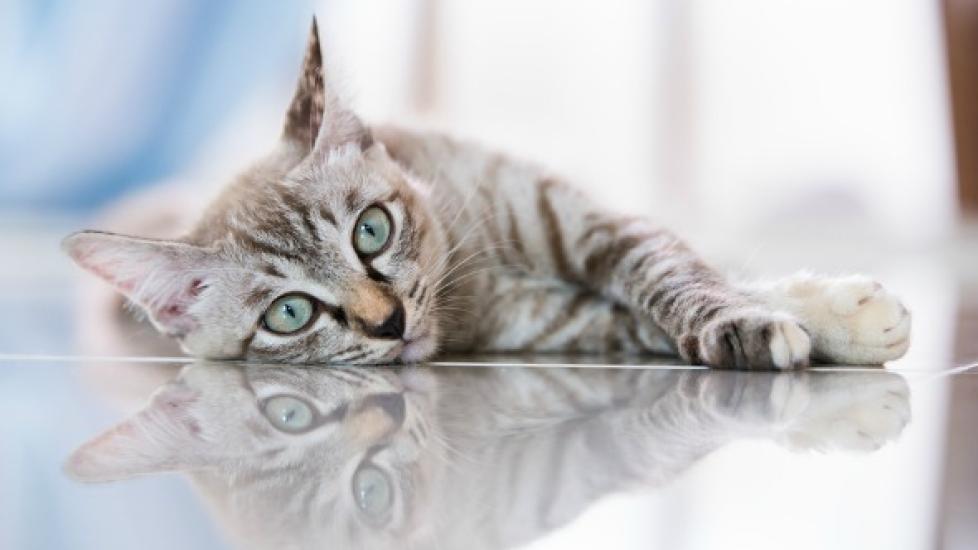Eosinophilic Granuloma Complex in Cats
Eosinophilic Granuloma Complex in Cats
Eosinophilic granuloma complex in cats often is a confusing term for three distinct syndromes that cause inflammation of the skin:
- Eosinophilic plaque - circumscribed, raised, round to oval lesions that frequently are ulcerated. They are usually located on the abdomen or thighs. These lesions contain a type of white blood cell called an eosinophil.
- Eosinophilic granuloma - a mass or nodular lesion containing eosinophils usually found on the back of the thighs, on the face, or in the mouth.
- Indolent ulcer – circumscribed, ulcerated lesions most frequently found on the upper lip.
The three syndromes are grouped together as eosinophilic granuloma complex, primarily according to their clinical similarities, their frequent simultaneous development, and their positive response to the same treatment with steroids.
Eosinophilic refers to eosinophils, a type of white-blood cell usually involved in allergic responses. Granuloma is a large inflammatory nodule or solid mass. And a complex is a group of signs or diseases that have an identifiable characteristic that makes them similar in some fashion.
The genetics are unknown, although several reports of related affected individuals and a study of disease development in a colony of cats indicate that in at least some individuals, genetic susceptibility (perhaps resulting in an inheritable dysfunction of eosinophils) is a significant component of the disease.
Specifically, eosinophilic granuloma complex is restricted to cats. While eosinophilic granulomas do occur in dogs and other species, they are not considered part of the eosinophilic granuloma complex. Breed does not appear to play a role in cats.
Eosinophilic plaque is circumscribed, raised, round-to-oval lesions that frequently are ulcerated and usually appear on the abdomen or thighs. The lesions contain a type of white blood cell called an eosinophil and usually affect cats in the two to six year age range. Genetically initiated eosinophilic granuloma is generally seen in cats that are younger than two years of age.
Allergic disorders usually develop after a cat has reached the age of two. In cats, females may be more likely to develop one or more of the syndromes of eosinophilic granuloma complex than are males.
Symptoms and Types
Lesions of more than one syndrome may occur simultaneously. Lesions of all three syndromes may develop spontaneously and suddenly.
Eosinophilic plaques:
- Circumscribed, raised, round to oval lesions frequently ulcerated
- Moist or glistening plaques (may have enlarged lymph nodes)
- Abdomen
- Near the chest
- Inner thigh area
- Near the anus
- Under front legs
- Hair loss
- Red skin
- Erosions
Eosinophilic granulomas:
- Linear orientation
- Back of the thigh
- Multiple lesions coming together
- Coarse, cobblestone pattern
- White or yellow
- Lip or chin swelling (edema)
- Footpad swelling
- Pain
- Lameness
Indolent ulcer:
- Ulcers of the mouth
- Found on upper lip
- Within the oral cavity, ulcers on gums
- Slightly raised margins
- Non-bleeding
- Usually painless
- May transform into a more malignant cancerous form (carcinoma)
Causes
- Non-specific allergies
- Allergic hypersensitivity reaction
- Food allergy
- Fleas
- Insects
- Genetic predisposition
Diagnosis
Your veterinarian will perform a complete physical exam on your cat. You will need to give a thorough history of your cat's health, onset of symptoms, and possible incidents that might have preceded this condition, such as an allergic reaction or flea infestation. Any information you have about your cat's genetic background may also be helpful in diagnosing this disorder. Your veterinarian will order a blood chemical profile, a complete blood count, an electrolyte panel and a urinalysis as part of the diagnostic process.
The physical exam should include a dermatologic exam, during which skin biopsies for a histopathology study will be taken. Skin scrapings will also be examined microscopically and cultured for the presence of bacteria, mycobacteria and fungi. Impression smears of the lesions should also be taken.
Treatment
Most cats may be treated on an outpatient basis unless the condition is severe and is causing your cat severe discomfort.
A food-elimination trial should be started for all cases in case it is a simple allergy. A diet which the cat has never been exposed to should be put in place using high protein meats, like lamb, pork, venison, or rabbit, exclusively for 8–10 weeks. After this time, reinstitute the previous diet and observe your cat for development of new lesions.
An environmental allergy (atopy) may be identified by intradermal skin testing in some cases. Your veterinarian will inject small amounts of dilute allergens intradermally (between layers of skin). A positive reaction (allergy) is indicated by the development of a hive or wheal at the injection site.
Your veterinarian will recommend and prescribe anti-inflammatory medications for immediate relief from the swelling and inflammation. Hyposensitization injections, which use minute amounts of the allergen to lessen sensitivity to the allergen in question, works for most cats and is preferable to long-term steroid administration.
Living and Management
Your veterinarian will schedule follow-up appointments with you in order to determine your cat's response to the food-elimination trial, and to monitor your cat's bloodwork. The results from the bloodwork is especially important if your cat has been prescribed immunosuppressive medication - as this will lower your cat's immune responsiveness to viruses and infections.
As much as possible, follow your veterinarian's recommendations regarding the dietary guidelines for your cat. The treatment plan will be adjusted at each follow-up appointment according to your cat's progress. If your veterinarian is able to determine an environmental cause of the allergy you will need to prevent your cat from being exposed to these allergens.
